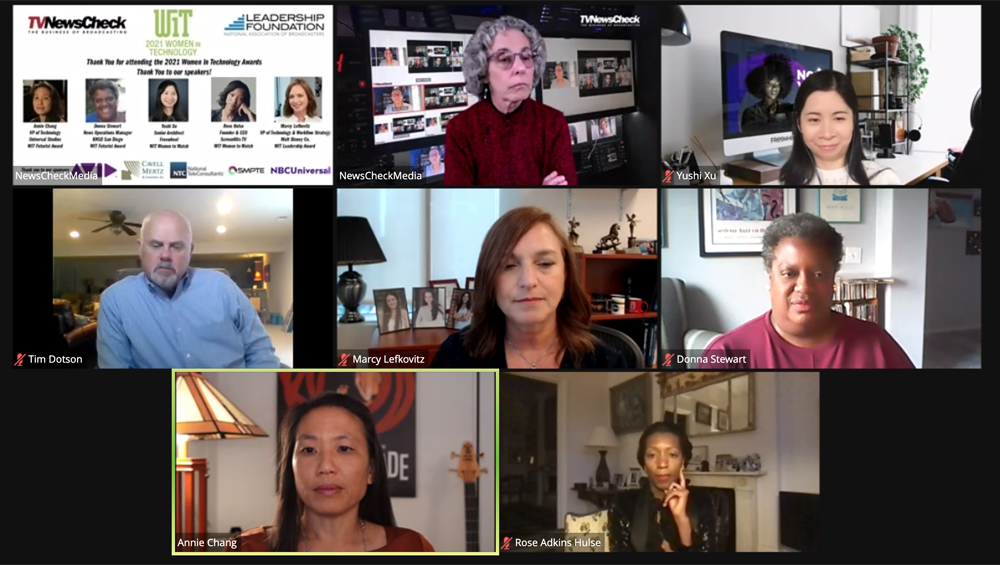
‘Cloud Is Sexy … But Expensive,’ Technologists Say

The broadcast industry embraced cloud technologies during the COVID pandemic, but costs will be a factor in what becomes the new normal for the industry.
2022 could see further uptake of cloud technologies as well as increased automation and rapid growth, TVNewsCheck’s five Women in Technology honorees said on Oct. 12 during its Technology in a Changing Media Ecosystem: Predictions for 2022 webinar.
Adopting cloud and remote technologies helped broadcasters “feed the beast” and meet audience needs during the pandemic. Even though these technologies can simplify workflows, if they are cost-prohibitive, broadcasters may revert to previous, less-costly workflows.
COVID “made our organizations a little bit less shy of embracing some radical changes,” said Marcy Lefkovitz, VP technology and workflow strategy, Disney Media & Entertainment Distribution, and recipient of the Women in Technology Leadership Award.
The remote and cloud-based workflows weren’t new, she said, but organizations hadn’t embraced them. Then, “seemingly overnight” they were “not just accepted but fully operationalized.”
Donna Stewart, who retired earlier this year as news operation manager at KNSD San Diego, an NBCUniversal Local station, is one of two Women in Technology Futurist Award winners. While the pandemic forced broadcasters to work in ways they hadn’t thought possible, she said she was “shocked at how seamless it was. We figured out how to make the technology work for us.”
Looking forward, the biggest goal is for content to flow directly from the field to the website without “needing to go through the middle management of editing and compiling” more seamlessly, she said. While it’s possible to stream straight from a device to the website, she said, “there are still a few hoops to jump through.”
Broadcasters need technologies that help them “feed the beast” cheaply but still make it possible for them to make money on the content while making the lives of personnel easier, Stewart said.
The main challenge, said Annie Chang, VP of creative technologies for Universal Pictures and a Women in Technology Futurist honoree, is “not the technology but the cost of the cloud.”
For on-prem work, broadcasters “don’t track how much data goes into and out of the server,” Chang said.
Even with benefits like better remote collaboration and the integrity of data, making production in the cloud feasible will require a different cost structure for the cloud, she said.
“We pay a certain amount today,” she said, but broadcasters are “unwilling to pay much more than that. We probably don’t want to pay more than 15% or 20% more than they pay now for those benefits.”
There has to be a “happy medium between what you pay now for your workflow versus what you would do in the future and what you would get out of it,” Chang said.
If the cloud is cost-prohibitive, she added, broadcasters may be willing to lose out on the benefits of the cloud and continue working on-prem.
As Lefkovitz put it: “The cloud is sexy, it’s enabling, but it is expensive. We have to be data-driven about what tools we use for what purposes. In many cases, it’s just unfortunately simply not worth it.”
Cloud charges are currently based on factors like storage, file size and movement of those files, and in the media industry, “our files are big,” she said. A charge structure tailored to the media and entertainment space’s needs would make it possible for broadcasters to use cloud workflows more, she said.
Chang agreed, saying, “We need something specifically for our industry.”
The rapid adoption of cloud and remote technologies had the unexpected result of making it likely that the MovieLabs 2030 vision, which was released before the pandemic, will be achieved much earlier, Chang said.
“2022 will be just another steppingstone towards the MovieLabs 2030 Vision,” Chang said.
Over the course of 2022, Yushi Xu, senior architect at FreeWheel and one of this year’s Women to Watch honorees, said she expects to see more of a push from quantitative measurements to qualitative measurements, so advertising becomes increasingly addressable and more audience-based.
Also, as there is a bigger need to identify an audience no matter what screen they’re behind at a time when third-party cookies are being phased out, Xu said, there will be a larger need for obtaining first-party data in a secure way.
Moving forward, there will be more need for scalability and efficiency, she said.
“In order to scale, that’s where automation comes in,” she said. Automation is less error-prone because human error is removed from the equation, she added.
Looking forward, Rose Hulse, founder & CEO of ScreenHits TV and a Women to Watch honoree, said 5G will be a “massive game changer” that brings streaming services to areas not normally known for streaming, such as trains, automobiles and airplanes.
Further, she said she foresees the increasing importance of having a single log-in that will make it possible to access all a user’s streaming services under one umbrella. To that end, she said, ScreenHits is working with a partner to make one log-in for streaming services a reality.
In 2022, the “biggest challenge is going to be how to control growth,” Hulse said. “There’s so much opportunity now. Can people keep up?”
































Comments (1)
SunnyAnd75 says:
October 14, 2021 at 8:43 am
“The cloud is sexy, it’s enabling, but it is expensive. We have to be data-driven about what tools we use for what purposes. In many cases, it’s just unfortunately simply not worth it.”
Finally- Someone said it! It’s so true. Why are companies moving from on prem to cloud? Primarily because it’s predicted revenue. Oh yeah, there’s added flexibility as well, but the biggest winner is the provider of these services.